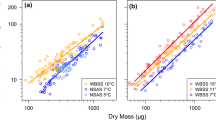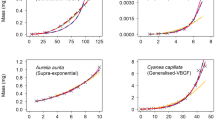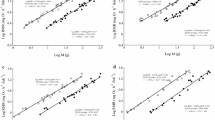Summary
After feeding the metabolic rate of animals rapidly increases to a peak level and thereafter slowly declines to pre-feeding level. This phenomenon has been termed the specific dynamic action of food. The processes causing the increase in metabolism are uncertain. In Asterias rubens there was a close relationship between the magnitude of SDA and growth rate (coefficient of determination=r 2=0.85), suggesting that the increased metabolic expenditure following feeding represent the energetic cost of growth.
Similar content being viewed by others
References
Ashworth A (1969) Metabolic rates during recovery from proteincalorie malnutrition: the need for a new concept of Specific Dynamic Action. Nature 223:407–409
Bayne BL, Scullard C (1977) An apparent specific dynamic action in Mytilus edulis. J mar biol Ass UK 57:371–378
Brett JR (1976) Feeding metabolic rates of young sockeye salmon, Oncorhyncus nerka, in relation to ration level and temperature. Fish Mar Serv Res Tech Rep 675
Brett JR (1979) Environmental Factors and Growth, In: Hour WS, Randall DJ, Brett JR (eds) vol 8 Bioenergetics and Growth, Academic Press, New York
Brett JR, Shelbourn JE, Shoop CT (1969) Growth rate and body composition of fingerling sockeye salmon, Oncorhyncus nerka, in relation to temperature and ration size. J Fish Res Bd Can 26:2363–2394
Broertjes JJS, Jens JN, Van Oudeheusen D, De Bruin M, Vogt PA (1982) Demonstration of nutrient flow in the starfish Asterias rubens (L) with 125I labelled proteins. Neth J Zool 32:472–478
Brooke OG, Ashworth A (1972) The influence of malnutrition on the post-prandial metabolic rate and respiratory quotient. Br J Nutr 27:407–415
Crisp M, Davenport J, Shumway SE (1978) Effect of feeding and of chemical stimulation on the oxygen uptake of Nassarius reticulatus (Gastropoda: Prosobranchia). J mar biol Ass UK 58:387–399
Hemmingsen AM (1960) Energy metabolism as related to body size and respiratory surfaces, and its evolution. Rep Steno Meml Hosp 9:7–110
Jobling M (1981) The influences of feeding on the metabolic rate of fishes: a short review. J Fish Biol 18:385–400
Jobling M, Davies PS (1980) Effects of feeding on the metabolic rate and the specific dynamic action in plaice, Pleuronectes platessa L. J Fish Biol 16:629–638
Kleiber M (1961) The Fire of Life: an Introduction to Animal Energetics. John Wiley and Sons, New York London
Krieger I (1966) The energy metabolism in infants with growth failure due to maternal deprivation, undernutrition or causes unknown. 1. Metabolic rate calculated from the insensible loss of weight. Pediatrics 38:63–76
Krieger I (1978) Relation of specific dynamic action of food to growth in rats. Am J Clin Nutr 31:764–768
Krieger I, Whitten CF (1969) Energy metabolism in infants with growth failure due to maternal deprivation, undernutrition or causes unknown. 2. Relationship between nitrogen balance, weight gain and post-prandial excess heat production. J Pediat 75:374–379
Lane JM, Lawrence JM (1979) The effect of size, temperature, oxygen level and nutritional condition on oxygen uptake in the sand dollar, Mellita quinquisperforata (Leske). Biol Bull mar biol Lab Woods Hole 157:275–287
Miura T, Suzuki N, Nagoshi M, Yamamura K (1976) The rate of production and food consumption of the Biwamusa, Oncorhynchus rhodurus, population in Lake Biwa. Researches Popul Ecol Kyoto Univ 17:135–154
Muir BS, Niimi AJ (1972) Oxygen consumption of the euryhaline fish aholehole (Kuhlia sandvicensis) with reference to salinity, swimming and food consumption. J Fish Res Bd Can 29:67–77
Nauen C (1982) A review of data on respiration of starfish and their potential use for defining starfish growth and ecological role. Kieler Meeresforsch 29:102–113
Parry GD (1978) Effects of growth and temperature acclimation on metabolic rate in the limpet, Cellana tramoserica (Gastropoda: Patellidae). J Anim Ecol 47:351–368
Tandler A, Beamish FWH (1979) Mechanical and biochemical components of apparent specific dynamic action in largemouth bass, Micropterus salmonides Lacépède. J Fish Biol 14:343–350
Vahl O (1978) Seasonal changes in oxygen consumption of the Iceland scallop (Chlamys islandica (O.F. Müller)) from 70° N. Ophelia 17:143–154
Vahl O, Davenport J (1979) Apparent specific dynamic action of food in the fish Blennius pholis. Mar Ecol Progr Ser 1:109–113
Zeuthen E (1953) Oxygen uptake as related to body size in organisms. Quart Rev Biol 28:1–12
Author information
Authors and Affiliations
Rights and permissions
About this article
Cite this article
Vahl, O. The relationship between specific dynamic action (SDA) and growth in the common starfish, Asterias rubens L.. Oecologia 61, 122–125 (1984). https://doi.org/10.1007/BF00379097
Received:
Issue Date:
DOI: https://doi.org/10.1007/BF00379097




